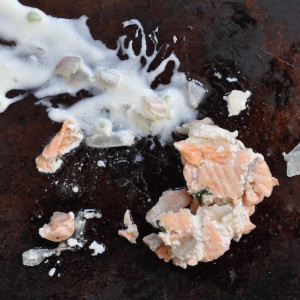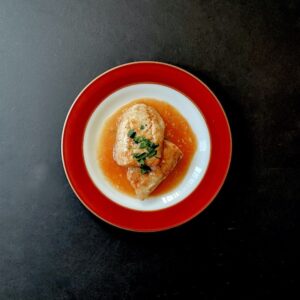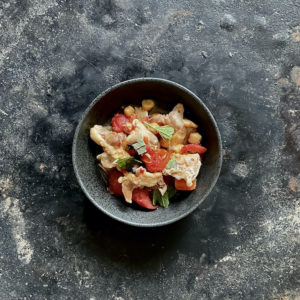Warm Farro Salad
Today’s post, as the world burns, is about warm farro salad.

Farro, otherwise known as emmer wheat, has yet to experience the ruinous fame that has struck tahini, quinoa, and miso.

Instead of picturing ruinous fame, I give you this funnel on my kitchen windowsill.
By “ruinous fame,” think foodie crazes leading to recipes like farro smoothies, farro summer salads, or fruity farro breakfast bakes.

All of the above are real recipes, made with quinoa, that darling of hip grain eaters everywhere.
Be grateful.
Returning to our warm farro salad.
I learned about farro from Judy Rodgers’ Zuni Cafe Cookbook. Following her recipe, I proceeded to prepare and eat farro for years. Then, as people who cook a lot tend to, I found other recipes and moved on. Over time I forget farro entirely.
Then, for no particular reason, I remembered farro. Don’t ask me why. I have reached the age where I can recall 1982 perfectly. Last night’s dinner? Another story.

Not last night’s dinner.
Then again, recent events are extremely distracting. Also distressing. In truth, world events are enough to send one screaming into the street. But we’re not doing that, because we are kind, civilized people who want a peaceful world, and running into the street would only add to the chaos.

Instead, we are going to make farro.

Farro’s flavor is best described as “nutty. ” This is unfortunate, as “nutty” is used only slightly more often than “umami,” But there you go.

In addition to tasting nutty, farro strongly resembles barley in taste and texture. Like barley, farro pairs well with lamb, chicken, pork, and game birds. It also makes a delicious main dish.

Farro is easy to prepare: saute a few aromatics in olive oil, add the grain, then add liquid to cover. This liquid may be water, broth, or a mixture of both. Bring to a boil, then simmer 15-20 minutes.

Farro is amenable to additions like fresh herbs, lemon juice, and diced fresh vegetables.

Or make farro plain, with just water and a little salt, and dress it with olive oil and lemon. You won’t be disappointed.

Warm Farro Salad
Preparation Time: about 30 minutes; most of this is cooking time
Serves: 2 people. Easily scaled upward.
Please see notes, below, before beginning to cook.
2-4 tablespoons olive oil
1 medium carrot, peeled or scrubbed and cut into dice
1 small onion, shallot, or 2 green onions, peeled and diced
1-2 garlic cloves, peeled and thinly sliced
scant 1/4 teaspoon dried oregano (or fresh if you have it)
scant 1/4 teaspoon fennel seed
scant 1/4 teaspoon fresh thyme
fresh parsley, including stems (optional)
a few peppercorns
1 teaspoon salt
1/2 cup/4 ounces/100 grams pearled farro
12 ounces/400ml unsalted chicken stock, vegetable stock, or water; you need enough liquid to cover the farro by about 1.5 inches/4cm. You may need more during cooking depending on how absorbent your farro is.
salt and pepper to taste
You need a 2-3 quart/liter pot to make Warm Farro Salad.
Heat the olive oil over low heat.
Add the carrot, whatever allium you’re using, and the garlic. Cook gently, stirring occasionally, until the onions become translucent. Don’t let them brown. There should be enough olive oil to moisten the vegetables generously.
Once the onions are translucent, add the seasonings and the farro. Stir with a wooden spoon, coating farro and vegetables with olive oil. Cook gently for a moment, as if making risotto. Don’t let anything brown.
Pour in the broth or water. It should come about 1.5 inches/4cm above the farro’s surface.
Bring the liquid to a boil, then turn it down to simmer. Don’t stir too often, or the grains will burst, creating mush. You want the farro intact.
Cook farro 15-25 minutes, until grain is done: it should be easy to chew but retain bite at the core.
Taste for salt and pepper. It will probably need salt.
Additional fresh parsley makes a nice addition, if you have it.
Serve warm farro salad as a side or main dish with a green salad and cheese.
Warm Farro Salad will keep, refrigerated in a covered container, up to four days. Freezing isn’t recommended.
Notes:
Pearling is a polishing process that removes bran from grain, allowing it to cook faster. I’ve never seen farro that wasn’t pearled, but if yours is intact, it will take longer to cook.
The seasonings given here are suggestions. Feel free to alter them to your taste.
Your farro may need more liquid, depending on how old it is and the kind of pot you’re using. The farro might also finish cooking before all the liquid is absorbed, leaving a small amount in the pot. If this happens, you have a few options. The first is to leave it. The second is to remove the farro to a dish, then turn up the heat and boil the remaining liquid off. The third is to pour off the liquid and use it elsewhere.
Farro may also be prepared like risotto: saute minced onion, garlic, and perhaps some carrot in olive oil and butter. Add the farro, stirring to coat the grains with fat. Add a little white wine to the pan, then some warmed broth. Farro prepared in this manner isn’t as demanding as risotto: you don’t have to stir constantly. Instead, you can stir frequently, adding broth as the grain absorbs it.
Farro also features in numerous Mediterranean soup recipes, often showing up with white beans and greens.
I conclude this post on October 12, 2023.
This is not a political blog. I am not a political pundit. But I’ve said this before, and it merits repeating: to write about food as if nothing else is happening feels callous at best. We may differ in views, politics, parties. That isn’t important. We can all acknowledge that innocent people are suffering, many of them children, and we wish that weren’t so.
Thank you for reading.





